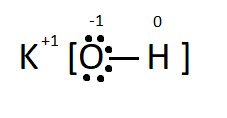
How do you draw the Lewis dot structure for KOH.
Answer
392.7k+ views
1 likes
Hint: Electron Dot structures also known as the Lewis electron Dot structures, are diagrams that depict the bonding between different atoms and also show their valence electrons and lone pairs, if any exists. It mostly has two types of dots
Complete answer:
The inorganic compound given to us is Potassium Hydroxide with the chemical formula KOH. The central atom is Oxygen. It is attached to one potassium and one Hydrogen. Oxygen belongs to the group 16 of the periodic table and has 6 valence electrons. Potassium belongs to the group 1 of the periodic table and has 1 valence electron. Potassium donates the one electron in its valence shell to form a monocation, oxygen gains that one electron from Potassium and one from Hydrogen making a total of 8 electrons in the outermost orbital. It becomes stable as it attains the stable electronic configuration. It is easier for the oxygen to gain 2 electrons than to lose all the six electrons. Hence oxygen acts as a base.
The Lewis dot structure deals with only the valence electrons of an element, and shows the bonding precisely. The outermost electron count can be easily figured out.

Here the
Note:
KOH is a very strong base and is commonly known as caustic soda. It is mainly used in the industries and has high reactivity towards acids. It is the important precursor for soft and liquid soaps as well as for numerous potassium-containing chemicals. It is white solid and is dangerously corrosive.
Complete answer:
The inorganic compound given to us is Potassium Hydroxide with the chemical formula KOH. The central atom is Oxygen. It is attached to one potassium and one Hydrogen. Oxygen belongs to the group 16 of the periodic table and has 6 valence electrons. Potassium belongs to the group 1 of the periodic table and has 1 valence electron. Potassium donates the one electron in its valence shell to form a monocation, oxygen gains that one electron from Potassium and one from Hydrogen making a total of 8 electrons in the outermost orbital. It becomes stable as it attains the stable electronic configuration. It is easier for the oxygen to gain 2 electrons than to lose all the six electrons. Hence oxygen acts as a base.
The Lewis dot structure deals with only the valence electrons of an element, and shows the bonding precisely. The outermost electron count can be easily figured out.

Here the
Note:
KOH is a very strong base and is commonly known as caustic soda. It is mainly used in the industries and has high reactivity towards acids. It is the important precursor for soft and liquid soaps as well as for numerous potassium-containing chemicals. It is white solid and is dangerously corrosive.
Latest Vedantu courses for you
Grade 10 | MAHARASHTRABOARD | SCHOOL | English
Vedantu 10 Maharashtra Pro Lite (2025-26)
School Full course for MAHARASHTRABOARD students
₹33,300 per year
Recently Updated Pages
Master Class 9 General Knowledge: Engaging Questions & Answers for Success

Master Class 9 English: Engaging Questions & Answers for Success

Master Class 9 Science: Engaging Questions & Answers for Success

Master Class 9 Social Science: Engaging Questions & Answers for Success

Master Class 9 Maths: Engaging Questions & Answers for Success

Class 9 Question and Answer - Your Ultimate Solutions Guide

Trending doubts
State and prove Bernoullis theorem class 11 physics CBSE

Who built the Grand Trunk Road AChandragupta Maurya class 11 social science CBSE

1 ton equals to A 100 kg B 1000 kg C 10 kg D 10000 class 11 physics CBSE

State the laws of reflection of light

One Metric ton is equal to kg A 10000 B 1000 C 100 class 11 physics CBSE

Difference Between Prokaryotic Cells and Eukaryotic Cells




